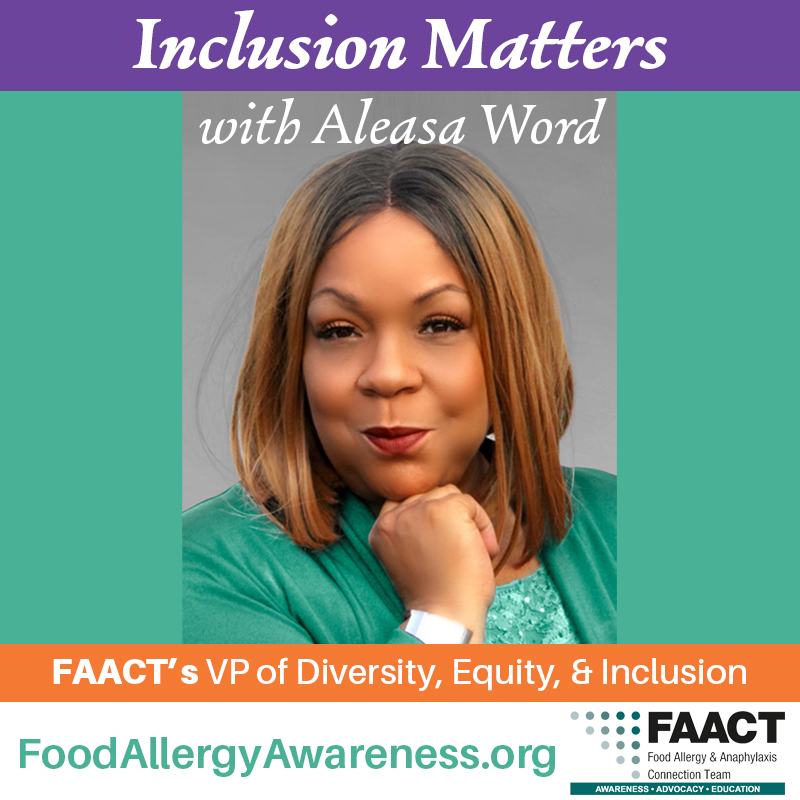What A Safe Space Really Means for People With Food Allergies
Subcategories

What A Safe Space Really Means for People With Food Allergies
by Aleasa Word, FAACT Vice President of Inclusion Initiatives
April 2025
When people claim to be “allergy friendly,” I often wonder, friendly to whom? For people like us in the food allergy community, we realize that being “allergy friendly” doesn’t always mean being “allergy safe” for everyone.
Many people with food allergies don’t get the opportunity to feel safe with food in all settings. Well-meaning individuals may purchase things like organic foods and think they’ve done their part in keeping everyone safe—while simply giving the allergic person an organic version of their allergen.
Whether it’s a school event, potluck, church outing, or family gathering, small oversights can lead to big consequences for those with food allergies.
The good news? Creating truly welcoming spaces for our community doesn’t have to be hard. With a dose of empathy, patience, and creativity, the possibilities for fun, safety, and building connection are endless.
Perceived vs. Actual Safety
- “Free of allergens” can be misleading: It’s much safer to say “free of [specific allergen]” and mean it. Blanket terms can give a false sense of security. The potential for errors is high, so please remain vigilant.
- Cross-contact is real: Many people don’t understand it, but it’s a game-changer. A single shared utensil, prep surface, or hand can turn a safe food into a danger zone. It’s good to remind others of this.
- Vague labels are a no-go: Inclusion requires clarity. Food should be labeled with accurate, specific ingredients and potential allergen warnings, not just “may contain.”
The Emotional Weight of Exclusion and Inclusion
- Some people will opt out instead of choosing to speak up: It is so exhausting to always have to ask others to think about our needs. That exhaustion often leads families to quietly stay home rather than be “that family” again. This is a personal choice, but only you know your level of comfort.
- Vocal parent, private child: This is a tricky dynamic. Sometimes the parent is loud about safety and the child just wants to blend in. Other times, the child speaks up while the adult is still learning. Safe spaces consider both and honor both. However, safety is always first!
How To Make Spaces Truly Safe and Welcoming
Creating a safe space doesn’t mean we are always able to eliminate all concerns. That can be tough to do, depending on the circumstances. It’s about making intentional choices that show that everyone matters!
Here are a few more things to consider:
- Ask people in advance about food allergy needs and listen (repeat over and over).
- Keep food packaging onsite for families/individuals to read (where age appropriate).
- Offer non-food activities and prizes so no one feels left out.
- Ask for feedback after events to continue learning and improving.
- Inclusion is about empathy and caring for others… if we all practice, we can make this work.
How a Safe Space Feels
- It feels like someone asking, “Is this safe for your child?” without being prompted.
- It looks like a table where no one has to eat alone.
- It sounds like, “We made sure there was something just for you.”
- It feels like someone took the extra step to show you that you are included and loved.
Safety Is a Shared Responsibility
Inclusion isn’t about finding a box to check, it’s about cultivating a sense of belonging. If you want to create spaces that are not just allergy friendly but allergy inclusive, it starts with a simple shift: listen, learn, and lead with empathy.
That’s how we build communities where everyone feels safe, valued, and welcome at the table.

